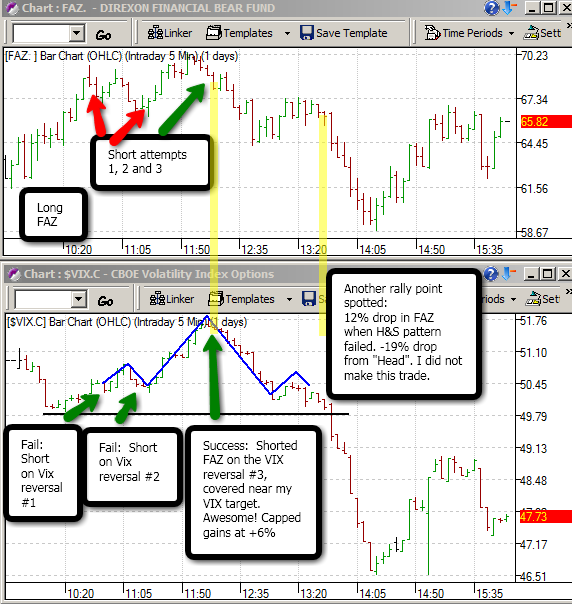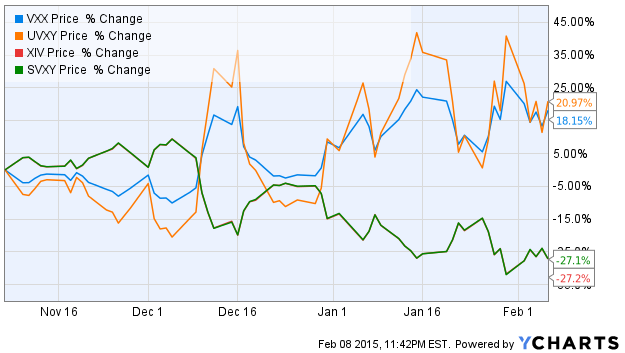Using The VIX For Shorting Opportunities
Post on: 16 Март, 2015 No Comment

The risks involved in short selling can never be overemphasized, which is why novice investors are cautioned against doing it. However, the advanced trader would be limiting him or herself by not exploring the various opportunities short selling can offer. Some investors, for example, will often protect themselves from downturns in the market with an offsetting short position, thereby protecting their long positions. Regardless of your purposes, it is always important to use indicators that help you discern shorting opportunities, and here we look at how the VIX can give you greater insight into market directions .
Defining Short Selling
When investors buy stocks for their portfolios. the term we use for acquiring an issue is ‘going long.’ If, however, the investor believes a stock is about to turn downward for a period of time, the investor may sell the stock (without first buying it), or ‘go short .’ An investor borrows the stock from his or her brokerage, sells the stock, and later buys it back again (or covers the position) at a lower price, effectively making a profit in a downtrend.
The borrowing process is relatively simple. The investor’s broker is asked to borrow the stock from another investor, and the short seller must provide cash collateral of about 50% of the price of the short sale. Also, the short seller is responsible for any dividend that may be paid while his or her position is still open. Remember, the short seller has only borrowed the stock — someone else holds the rights that come with ownership.
The Dangers and the Short Squeeze
Every short seller should also be aware of the short squeeze. which occurs if the brokerage firm recalls the stock that you have borrowed and you have a difficult time buying back into the market because of the lack of market liquidity. A short squeeze finds traders with an increased demand for an issue that is in short supply, and the stock price is therefore driven higher. Investment and hedge fund managers watching support levels will rush into a stock they believe is ripe for the picking at cheaper prices. Because of the size of blocks of stock with which these large funds come to the market, the stock price can move upward very quickly and without warning. squeezing short sellers and forcing them to buy back in and cover their positions, which in turn pushes the stock price even higher!
Short sellers need to understand support levels, and be prepared to buy back into the market just above the support zone. Why just above the support zone? Well, everyone else is looking at the same support levels on the same charts you are, so by placing yourself just above the support zone, you have a better chance of covering your outstanding position before the herd.
The Chicago Board Options Exchange (CBOE) volatility index, or VIX, measures market volatility. Essentially the VIX forms a hypothetical at-the-money option that will expire in 30 days. When originally designed in 1993, it was calculated using a weighted average of the implied volatilities of eight S&P 100 index options (OEX ) with an average expiration date 30 days into the future.
In September 2003, the CBOE made some amendments to the VIX, basing it on prices of the S&P 500 (SPX) options and devising a new formula to take into account a much wider range of strike prices. Also, the at-the-money strikes now have the most weight. But the basic concept remains the same, and the new VIX plays out much the same as its predecessor.
In its uses, the VIX gauges investors’ confidence in the market conditions and is a good measurement of whether OEX options are overvalued or undervalued. If the VIX reading is low, below 20 to 25%, the sentiment is one of disinterest: investors are quite content with the direction the market is taking in general. A rising VIX has investors coming back into the marketplace with what could be a market turnaround. If stock valuations are falling off and the VIX is rising, investors who have shorted a stock should worry that the increased interest in that issue could sharply turn the stock upward with gusto over a short period of time.
Using the VIX in Short Selling
Here is an interesting situation that may show how a short seller can use the VIX in his or her strategy. When looking at the huge jump in convertible bonds issued in 2003 (Thomson Financial indicated an increase of convertibles from $60 billion to $96 billion year over year), some analysts concluded that, with the enormous amount of call options available, the supply would rise, the prices would fall and the VIX would fall off.
Let me connect the dots for you. A convertible bond gives an investor the option to convert to the stock on the same company at a set price — it’s not unlike a call option. With interest rates at a generational low and investors looking for a strong yield return, it is no wonder the numbers jumped to $96 billion.

In the first chart you can see the trading activity of the Dow Jones Industrial Average (DJIA) in the last months of 2003. Plain to see is the lack of interest shown by investors in the VIX Index as the DJIA shows a continuing upward trend. Again, this doesn’t mean that investors do not have interest — even though it indicates they are content with the direction it is currently taking, which is a steady upward trend. The VIX is falling off under the table, well below the 25% mark.
In the second chart, I have run some support lines that investors as well as institutional traders would watch if the market were to turn around sharply and head lower. The first area of support is established on October 24 at about 9500 (#1 in the first chart), and the second area that would be watched is developed around September 30 — October 1, when the Dow dances around the 9275-9300 levels (#2 in the first chart). And thirdly, on August 6, the Dow closes at 8993,(#3), so the seasoned market players would be watching the 9000 level closely as a level of support, both numerically as well as psychologically.
It is important to note that market veterans would use much smaller time frames to see a turnaround in sentiment sooner. Next time you are looking at your charts, change your time frame from daily bar charts to 30-minute views or less. A market can move very quickly and sometimes it happens in a matter of a few short hours.
Conclusion
Take a serious look at the support levels before jumping into the short selling forum, and bring the VIX along for greater insight into the directions the markets are taking. Above all, stay on top of any short selling. The markets can turn on a dime. Don’t get ‘squeezed’ out of the game.
For related reading, see Volatility — The Birth Of A New Asset Class .














